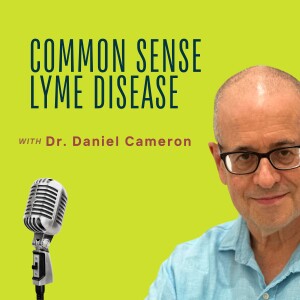
Inside Lyme Podcast with Dr. Daniel Cameron
Health & Fitness:Medicine

Since opening my Lyme disease practice in 1987, I’ve witnessed significant changes in how we diagnose and treat this complex illness. Early on, I prescribed doxycycline for Lyme disease and Ehrlichia. However, my first three patients in 1987 did not respond to doxycycline, so I referred one to Boston for further consultation. They returned with a recommendation for amoxicillin, marking the first major shift in my treatment approach.
By 1990, I had started prescribing intravenous ceftriaxone (Rocephin), based on emerging reports of its effectiveness in chronic neurologic Lyme disease. This adjustment was influenced by reports from doctors Dr. Logigian, Kaplan and Steere, who documented treatment of chronic neurologic Lyme disease cases.
I added azithromycin (marked as Zithromax in the USA) and clarithromycin (marketed as Biaxin I the USA) into my practice, based on emerging reports of its effectiveness.
My practice changed again when Dr. Krause and colleagues reported the presence of Babesia, a parasite found in the same ticks that carry Lyme disease. At the time, treating Babesia was challenging, as the available regimen of clindamycin and quinine was difficult for patients to tolerate. The introduction of alternative treatments like atovaquone (Mepron) combined with azithromycin provided a more tolerable option, and I began prescribing these, particularly for patients who were not improving with other antibiotics.
Over the years, I’ve adapted my practice to include longer treatment durations and combination antibiotic therapies, especially in cases of chronic or persistent Lyme disease. I’ve also incorporated treatments for co-infections like Bartonella, which was initially thought to be associated with cat scratches but is now recognized as a potential tick-borne illness.
In addition to antibiotics, I’ve kept a close eye on new developments, such as the use of disulfiram (Antabuse) and double-dose dapsone, which has been explored by Dr. Horowitz for its potential benefits in treating chronic Lyme disease. While I have not yet adopted these treatments extensively, I remain open to new evidence-based approaches.
The concept of biofilms and persisters—bacteria that survive despite standard treatment—has also influenced my practice. The persister hypothesis borrowed from research on other persistent infections like tuberculosis, suggest that longer or more aggressive treatment may be necessary for some patients.
While antibiotics remain the cornerstone of my treatment approach, I also recognize the role of alternative therapies for some patients. I collaborate with alternative medicine practitioners when needed, ensuring that every patient receives a comprehensive and closely monitored treatment plan.
I continue to share my experiences and insights through writing and social media, fostering dialogue and contributing to the ongoing conversation about Lyme disease treatment.
More Episodes
 2022-03-15
2022-03-15
 2022-01-25
2022-01-25
 2022-01-09
2022-01-09
 2021-05-03
2021-05-03
Create your
podcast in
minutes
- Full-featured podcast site
- Unlimited storage and bandwidth
- Comprehensive podcast stats
- Distribute to Apple Podcasts, Spotify, and more
- Make money with your podcast
It is Free
- Privacy Policy
- Cookie Policy
- Terms of Use
- Consent Preferences
- Copyright © 2015-2024 Podbean.com





